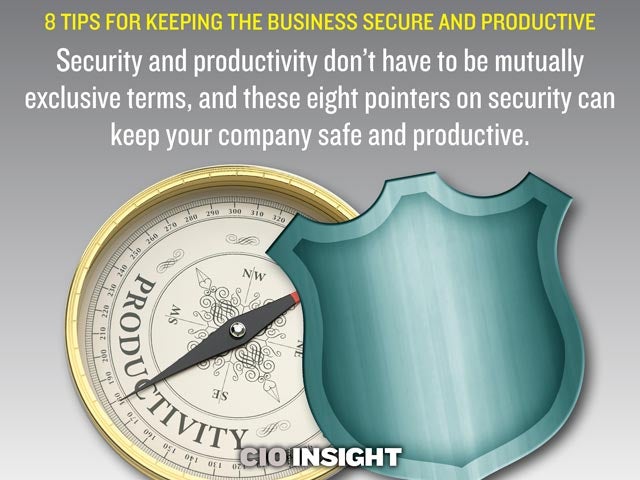
8 Tips for Keeping the Business Secure and Productive
 8 Tips for Keeping the Business Secure and Productive
8 Tips for Keeping the Business Secure and Productive
Security and productivity don’t have to be mutually exclusive terms, and these eight pointers on security can keep your company safe and productive.
 Conduct a Needs Assessment
Conduct a Needs Assessment
A successful strategy will be informed by historical data while also providing easy, non-disruptive processes for employees to follow.
 Network Internally
Network Internally
Get to know your user base by understanding what “a day in the life of” really means across your company. Shadowing a salesperson twice a year, for example, can lead to a better understanding of how all major roles in the enterprise interact with technology throughout the day, what their productivity and technology needs are, and potential security risks they might encounter.
 Make it Personal
Make it Personal
To demonstrate the value of security, make it personal by explaining how a data breach would impact employees so that they are more likely to uphold policies that protect their devices and networks.
 Address Cultural Barriers
Address Cultural Barriers
Address any underlying cultural challenges–such as the use of unsanctioned apps–to ensure that employees seamlessly adapt to new processes and tools. If you don’t, people will create workarounds.
 Prioritize the Business Process
Prioritize the Business Process
Prioritize business processes over technology. Too many CIOs decide on the technology first and try to adapt business processes later. Instead, take an operations-first approach and begin by understanding each employee’s business concerns and goals. Use this knowledge to inform the security strategy.
 Prioritize Customer Relationships
Prioritize Customer Relationships
It takes years to earn customers’ trust, so it’s crucial that security policies respect their data and properly protect information. To maintain valuable customer relationships, ensure that data management and retention policies protect against data getting into the wrong hands.
 Prepare for the Worst
Prepare for the Worst
Security incidents can happen at any time and cause major damage before you even know they’ve struck. In addition to following best practices, every organization needs a contingency plan. Incorporating practices that will allow you to understand what, how and when data was lost and the potential impact.
 Don’t Forget Your Endpoints
Don’t Forget Your Endpoints
To protect against unforeseen circumstances and address the increasing proliferation of data on the edge of the corporate network, incorporate an endpoint backup solution into your security strategy.